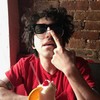Doug Aitken, Black Mirror, 2011, still
Doug Aitken (second from left) in conversation with (L to R) Laura Brown of Harper’s Bazaar, Daniel Birnbaum of Moderna Museet, artist Jordan Wolfson, and Staffan Ahrenberg of Cahiers d’Art. Photo: Kristoffer Ruckemann, courtesy Stockholm Symposium
Doug Aitken at Symposium Stockholm. Photo: Kristoffer Ruckemann, courtesy Symposium Stockholm
Doug Aitken, SONG 1, 2012, installation view, Hirshhorn Museum and Sculpture Garden. Photo: Frederick Charles
Doug Aitken, migration (empire), 2008, still
Doug Aitken, the handle comes up, the hammer comes down, Theater Basel, Basel, Switzerland, 2009, documentation still
Doug Aitken, SONG 1, 2012, installation view, Hirshhorn Museum and Sculpture Garden. Photo: Brian Doyle
